

Flying Jeep Hafner Rotabuggy and Rotachute
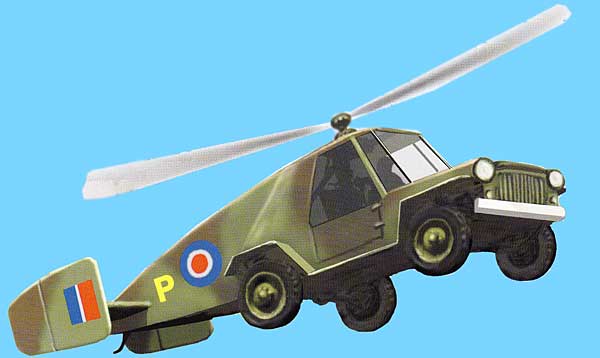
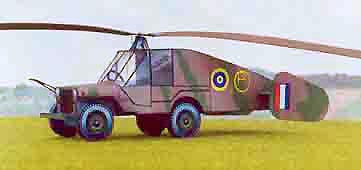
The Rotachute-Rotabuggy was found to be a fairly simple machine to fly and to land in a restricted area.
However, the operational needs for which it was designed never materialized.
Rotachute experience did provide a basis for much of today's knowledge
of light rotorcraft.
The rotorcraft team of the Airborne Forces Experimental Establishment
(AFEE), handled by Raoul Hafner, had enjoyed some success in developing
the so-called Rotachute (the idea of using a rotor rather than a
parachute as a means of pinpoint landing troops in enemy territory),
This led to the suggestion that the principle could be applied to
larger loads.
This prompted Hafner to propose the Rotabuggy,.A rotor-equipped Jeep, and THEN the Rotatank, a similarly-equipped Valentine tank. (yeah right..) The project was soon abandoned despite the government's claim that it was a smashing success.
One of the many experiments undertaken in World War II to increase battlefield mobility by the provision of rotary wings for men and vehicles, the Hafner Rotabuggy was intended as a stepping-stone to a flying Valentine tank.
Hey Wayne, All those guys are gonna swallow their tongues when they see this thing. Don't be surprised if somebody in the Pentagon sees this and wants to resurrect the idea..Matt, how about a "Flying Hummer"? ;-) CG
Hoo hoo, Mama it burns. That is one hot model!!. I can hardly wait. Get paint on it and put it out there. That bad boy just feels gooooood. RM
"Wayne, wanted to thank you for the Flying Jeep model. With out people like you, most of us paper gluers would have nothing to do but plastic models. I have no artistic talent at all and stand in awe of you people that do Again, thank you. PS-It goes without saying that the model is beautiful. W G (Apr, 01)
Just finished the Jeep. It went together fine. Wayne did a good job. Hope to have some pictures for you tomorrow. SJ
Back in 1991 I went to Oxford to interview the man who was the test pilot on the Rotabuggy project, Ian Little, who when I met him was an economist lecturing at the university. I was writing a dissertation on claims that Raoul Hafner (the flying jeep's designer) had designed the first helicopter before his work was plagiarised by Sikorsky - a claim I later disproved. The claim, incidentally, had been made by Hafner's widow, who I'd met in Bristol, quite by accident, when I was at university there.
I found Little a charming and modest man. I described him as a hero, but he was having none of it. He was in a safe job, he said, when real heroes were dying in bombers etc. But if my readings of the research studies are anything to go by, those rotachute and rotabuggy experiments were far from danger-free. He gave me quite a lot of detail about the instability of the rotor and about his efforts to fly it. After 17 minutes fighting to keep it stable behind a Whitley, he was helped from the cabin in a state of near collapse.
Incidentally, I learned that the Rotachute became the basis of the Bensen autogyro and it is claimed, quite probably apocryphally, that Bensen kept the Bren gun brackets beneath the keel because he was unsure what they were for and feared designing them out. The Bensen was adapted by Ken Wallis for his autogyros (WA116 - James Bond's Little Nellie). I interviewed Ken Wallis for the dissertation too. During the war Ken Wallis flew Lancasters.
all the best
Peter Eveleigh p.s. Long time since I made a paper plane. Must do something about that!
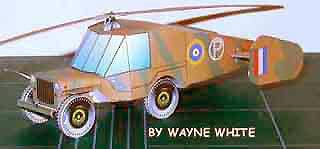 |
|
The Hafner Rotabuggy
- a standard Army "Jeep" with free-wheeling rotor and stabilizing tail unit.
|
Raoul Hafner's wartime work included the design and development of the Rotachute, a man carrying glider with a rotating wing. Towed by an aircraft to heights of some 4,000 ft, it could be piloted in any direction after release. This was seen as a stage in the development of a man carrying 'parachute' with a rotating wing that could be carried in an aircraft in a folded state and would deploy automatically when used in an emergency. Other wartime work was concentrated on the development of a Rotabuggy, basically a 'jeep'-type general-purpose military truck with an easily attached/detached rotary wing that would allow such vehicles to be towed and deployed behind enemy lines. A prototype was flown extensively during 1943-44, but did not become operational. In the postwar years, Raoul Hafner's great experience of rotating wings proved valuable to the Bristol and est;and aircraft companies |
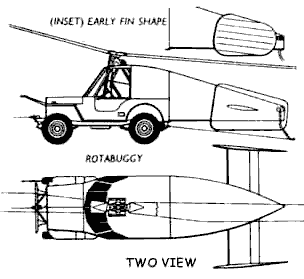
|
The first trials connected with the development of the Rotabuggy consisted of loading a Jeep or, more formally, a Willy's Truck 4x4 model MB, with concrete and dropping it from heights up to 8 ft to ascertain the amount of g that could be absorbed without incurring damage. It was found that 11g could safely be accepted, and a two-bladed rotor with a diameter of 40 ft 8 in. was the fitted, and a streamlined tail fairing, tailplane and twin fins (no rudders) were applied, together with a "hanging" control column, a rotor tachometer and glider navigational instruments.
The initial problems were progressively ironed out, and the general handling and flying qualities of the Rotabuggy were eventually described officially as "highly satisfactory", but the availability of vehicle-carrying gliders rendered further development unnecessary. |
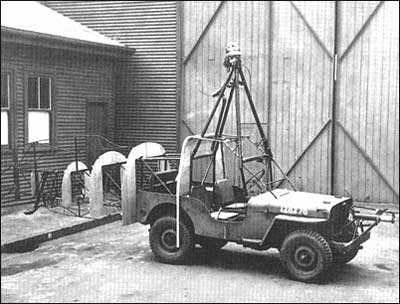 |
One of several failed concepts for the equipping airborne forces, the effort and risk in getting the Rotabuggy into battle would probably have outweighed its utility. |
The work of the Airborne Forces Experimental Establishment at Ringway, Manchester, on the Rotachute from 1940 onwards led to the suggestion that the free-wheeling autogyro principles employed could also be applied to larger loads. The designer, Raoul Hafner, suggested the Rotabuggy, a Jeep (or "Blitz Buggy") with rotors, and the Rotatank, a similarly modified Valentine tank. A development contract was placed with the M.L. Aviation Company at White Waltham in 1942, covered by specification 10/42. Preliminary tests involved loading a Jeep with concrete and dropping it from heights of up to 8 ft. , demonstrating that the standard vehicle could survive undamaged from impacts of up to 11g. A 40 ft. 8 in. dia. two-blade rotor was then fitted., as well as a streamlined tail fairing with twin rudderless fins. Other additions were perspex door panels, a 'hanging' rotor control next to the steering wheel and a rotor tachometer and glider navigational instruments.
The Rotabuggy, camouflaged, carrying RAF roundels and a prototype
"P", was tow tested behind a 4 liter supercharged Bentley,
and achieved gliding speeds of up to 65 mph. The
first flight was made on November 16, 1943. Later, some flights
were made behind a Whitley bomber from Sherbourne-in-Elmet. One
witness described how she watched a Whitley take off with a Jeep
in tow, circle and land. The Jeep, still in tow, did not touch
down at the same time, and the witness realized that its occupants
"were unhappy".
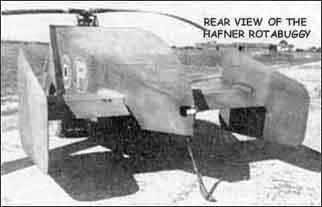
With the pilot holding the hanging control column and the driver
clutching the steering wheel, the Jeep made a series of up and
down movements, whilst the audience hoped it would stall on a
'down' rather than an 'up'. This it fortunately did, the driver
taking over and driving flat-out after the Whitley, to which it
remained attached. When it stopped, nobody got out for a while;
the pilot was then assisted out and lay down beside the runway
to recover. Apparently he was exhausted from trying to control
the joystick, which had whipped in circles for the whole flight.

Apparently this flight was one of the worst, and the handling
and flying qualities of the Rotabuggy were officially recorded
as "highly satisfactory", especially when large tail
fins had been fitted and greater rotor blade articulation provided.
However, development of Horsa II and Hamilcar vehicle carrying
gliders made further development of the idea unnecessary.
| The Rotabuggy had a gross weight of 3110 lbs of which 964kg was the empty weight of the Jeep and 549 lbs the weight of the rotor unit and tail. The design max speed was 150 mph, and estimated rates of descent ranged from 4.9m/s to 10m/s. The minimum take-off and landing speed was 36 mph, and basic and max sea level rotor speeds were 230 and 260rpm. |
|
The beta model had two pieces that looked like wheel wells for the rear of the contraption but I did not use them.. Also I noticed on the Alpha model that these pieces were gone. I also noticed a change in the bumper and the brackets. To mount the rotor I used a piece of aluminum tubing into which a pin was used for the shaft. The breeze kept the rotor rotating outside while I made the pix...pretty cool...but the funny thing was, she never blew over....must have been the six cases of Beefeater that was stowed in the back.
Wayne must be an areteriole and ganglion brain surgeon. I used a coffee stirrer wooden stick about 1/2 inch long for the center of the rotor. As you said, look how cool the blades droop! I'm still trying to figure out how to mount the two Jetex 50's on the rotor tips......a thought generated by the Norflugel.......of course I'll have to build the larger version to do it...this one is too small.The soldier shot a squirrel before he left. The P-40 pulled him off...he said something about a Belushi pilot with a cigar.... Hope this helps out! Duckbarn |
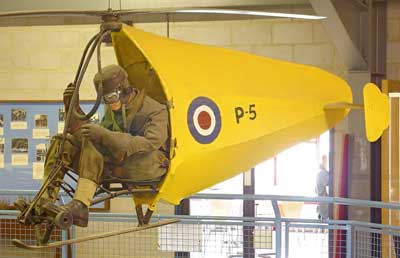
Raoul Hafner had created his first aircraft design in Austria in 1929, a helicopter. He came to England where he proceeded to develop a somewhat successful gyroplane. He continued with other designs, some tendered to requirements of early Air Ministry helicopter specifications.
By 1940 he was in charge of a rotorcraft team at the Airborne
Forces Experimental Establishment at Ringway, Manchester, where
the idea of using a rotor instead of a parachute to more accurately
deliver personnel into enemy territory was developed.
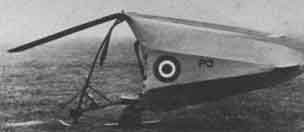 On October 3, 1940, work began on what would become the Rotachute;
practical testing began only eight days later with 3 ft. rotor blades attached to lead ballast. Test drops from a Whitley
bomber showed that, whilst the models lacked strength, a properly
ballasted rotor could achieve stable flight. A new model with
two metal blades and a total weight of 5 lb. was built,
and launches from a Whitley on October 16th and from the inter plane
struts of a Tiger Moth on November 7th were only partially successful,
but on November 15th a good descent from a Tiger Moth was achieved. The
next step was to build a larger model with 10 ft rotor
span and weight of 1000 lb.
On October 3, 1940, work began on what would become the Rotachute;
practical testing began only eight days later with 3 ft. rotor blades attached to lead ballast. Test drops from a Whitley
bomber showed that, whilst the models lacked strength, a properly
ballasted rotor could achieve stable flight. A new model with
two metal blades and a total weight of 5 lb. was built,
and launches from a Whitley on October 16th and from the inter plane
struts of a Tiger Moth on November 7th were only partially successful,
but on November 15th a good descent from a Tiger Moth was achieved. The
next step was to build a larger model with 10 ft rotor
span and weight of 1000 lb.
After stability tests on the ground on February 19,1942, the model was successfully launched from a special structure on the inter plane struts of a Boulton Paul Overstrand bomber, near Manchester on March 14. The model descended from 2,000 ft. at 1,500 ft/min. Meanwhile, from late 1940, Hafner had been working on the designs of a full-scale Rotachute. One concept was to carry several in a rail on the top of a modified troop-carrying aircraft and launch them rapidly, one after the other, from the tail end, to land in as tight a group as was required.
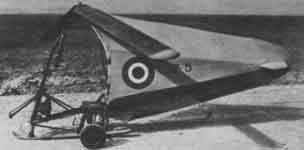
The Rotachute was designed to fit criteria of simplicity, light weight and reliability. It comprised a steel tube frame to seat the pilot, a two-bladed rotor with freely flapping blades, and a rubber mounted skid. The rotor hub was also rubber-mounted, to dampen vibration and to function as a control hinge. The fuselage was open at the front. A tapered fairing behind the pilot established the craft, and this was made entirely of rubberized fabric, with no framework, and was inflated to shape, with the intent of minimizing stowage space.
Control was by means of a single stick fixed to the rotor hub.
Turns were simply a product of banking. As designed, the Rotachute
had a weight of 50 lb. and a useful load of about 240
lb., which might comprise the pilot, his parachute and
a Bren gun Mk.1 with 300 rounds. The rotor diameter was 15 ft.,
making it the smallest man-carrying vehicle capable
of controlled flight ever built to that time. Contracts for Rotachute
production were placed.
Before flight trials began, tests were made with rotors and a complete unit fixed to moving vehicles. Early in 1942, the first flights took place. Two trials at Ringway in February ended with heavy landings, the craft overturning and breaking the rotors. A third run on a longer runway at Snaith was a little better, and it was decided, at least for training, to fit a three-point wheeled undercarriage (rather than a jettisonable trolley), and stabilizing fins. This required an extension of the tail fairing, which could no longer retain strength sufficient to avoid fouling the rotor without addition of a frame. A light frame and tailplane were added, the whole being inflated by ram effect from forward movement. This, the Rotachute Mk.II, first flew in late May, 1942, towed behind a Jeep for about 15 seconds of flight. Further tests led to satisfactory ground-initiated flights of two or three minutes. Work now began on the Mk.III.
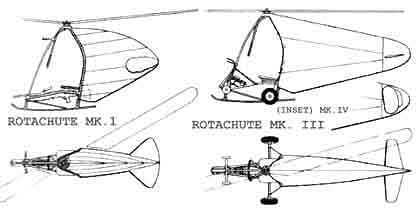
Tests began at Ringway of the Mk.III in June 1942, with towed
flights of around four minutes ending in controlled
landings. A totally free landing followed. The Rotachute was then
towed behind a Tiger Moth until it, but not the tow aircraft,
achieved takeoff. Further flights led eventually to towed air
launches, the Rotakite reaching altitudes of up to 3,900 ft., and reaching 93 mph and flight duration of up
to 40 minutes.
Subsequent tests using the Rotachute were concerned with development
of the Rotabuggy, a Jeep fitted with a rotor and tail unit in
much the same configuration. the Rotachute was developed to a
Mk.IV, with vertical fins added to the tailplane.
The Rotachute was found to be a fairly simple machine to fly and
to land in a restricted area. However, the operational needs for
which it was designed never materialized. Rotachute experience
did provide a basis for much of today's knowledge of light rotorcraft.
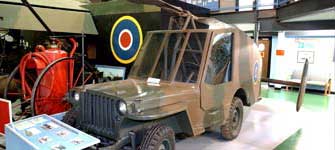
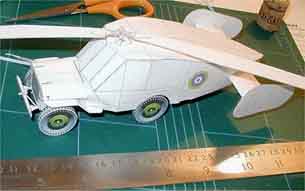 |
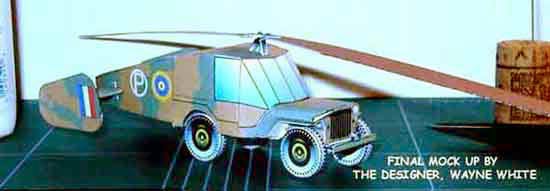 To share with you, dear modeler, we've kept the running commentary Wayne sent in as he was designing this little puppy.. This colorful documentation is as interesting as the model itself.. |
Wayne sends us these
photos of his first mock up. Note that the next step is to widen
the front section. He'll also be figuring out the connection
method of the tail. Details are still sketchy which is good.
BUT his work area is MUCH too tidy! hehehe The plans shown below
were used for the model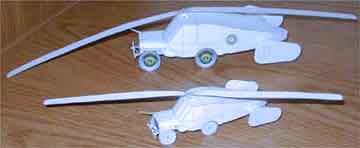 |
|
|
Have a look, give it grief and make some suggestions (please be nice, I don't think it'll fit comfortably where I fear some suggestions may be directed)... Whew! This de-zy-nin's fun...ZdS BTW: I started to give the Flying Jeep a little color and have been using the Hurricane (lovely bird, Chip) as a "go-by." I initially gave the underside the same underside color as the Hurricane but then stopped myself (as though something like a gaggle of jeep dropping from the sky required stealth). Any advise on how much detail to add to the undercarriage? In my research I have found a good number of photos illustrating the underside of jeeps but I don't want to get too carried away. Although, the more I think about it, if its just coloring it couldn't hurt. Wayne Working on cool(u)ring/detailing/instructions. Might be ready, oh, let's see... Maybe June (notice I didn't say WHICH June)...The bad thing now is that I can see the headlight of the on-coming train I'm thinking about the next one or two or three (spotted a dandy 3-view of the Weir (1934) W-2 Autogyro... Should be much more simple than the PA-36; straight cones and cylinders). But enough of that, back to the Jeep. By the way, would things be identified as belonging on the right/left/front/rear or starboard/port/forward/aft? Being of British design the driver's side would be on the right which precludes driver's side vs. passenger side...Oh why didn't I design a shipping container? Why oh why oh why? Having more fun than's legal in most country's, I remain. |
(Designer's notes....) This beast was an obvious failure (it'd only take something
like 72 MPH so As best as I can find the thing was supposed to be somewhat
disassembled The Rotachute's next (god, I AM weird) Thank god its a Brit design...We Yanks get the piss taken
out of us often Should have said something about that windshield and construction order. The best luck I had was attaching the windshield to the top then to the body; sort of working one's way around clock or counter-clockwise (or should that be anti-clockwise?) from the first straight place nearest the front. I added the tabs at the last minute ...I HATE tabs with a deep and abiding passion but I also realize many people use them...so there they are. I'll kill 'em (a vote of two counts heavily...no recounts...no court cases...no appointed presi...oops...dont do down that road boy). I also have a former in there that goes under the cowling I also HATE formers but just couldn't quite get away from it. I noticed that by the time the windshield got stuck on the hood had a viciously noticeable sag. I'd hoped the tolerances would be such that the damned thing just sat there perfectly awaiting a drop or two of glue (I prefer Elmers ;-) to hold it all together. Alas 'was not to be... Suspension? Oh how I wanted to but the part count is already in excess of thirty and I wanted to keep this fairly simple...The suspension should be fairly straight forward...Lema give it a go. Maybe an "upgrade?" |
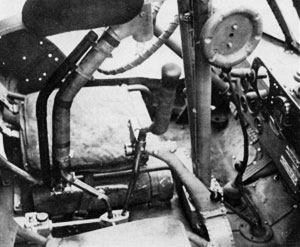 |
The "Cockpit" of the Hafner Rotabuggy Flying Jeep. |
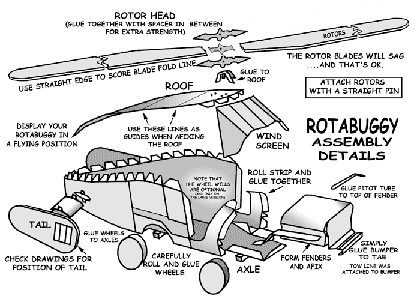
 |
|||
| A: Additional equipment included a rotor tachometer and some basic flight instruments take from a glider. | B: The Rotabuggy was fitted with a streamlined tail fairing with twin rudderless fins. Later larger area fins were fitted, but still had to be a horizontal shape to ensure clearance of the rotors. | C: The strength of the basic jeep was tested by filling it with concrete and dropping it from a height of 8 ft. proving that it could withstand impacts of 11g. | D: The rotabuggy was crewed by two men, one of whom drove using the regular controls, and the other who controlled the rotor using a column which hung down from the cabin roof. |




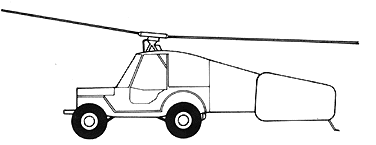 Austrian Raoul Hafner began
preliminary work on helicopter models in the mid 1920s, and in
1928 began the design of his first aircraft, the Hafner R. l helicopter
Financed by the Scottish cotton millionaire, Major J. A. Coats,
this had a comparatively short fuselage and a large diameter
(9.14 m/30ft) three-bladed main rotor; power was provided by
a 30-hp ABC Scorpion flat-twin piston engine. When
tested at Vienna in 1930 it was soon found that the gyroscopic
action of this rotor was too great and as a result, only a few
brief hops were made.
Austrian Raoul Hafner began
preliminary work on helicopter models in the mid 1920s, and in
1928 began the design of his first aircraft, the Hafner R. l helicopter
Financed by the Scottish cotton millionaire, Major J. A. Coats,
this had a comparatively short fuselage and a large diameter
(9.14 m/30ft) three-bladed main rotor; power was provided by
a 30-hp ABC Scorpion flat-twin piston engine. When
tested at Vienna in 1930 it was soon found that the gyroscopic
action of this rotor was too great and as a result, only a few
brief hops were made. The Rotabuggy was first towed along the runway at high speed
behind a 4.5l supercharged Bentley, eventually attaining towed
airborne speeds up to 65 mph, the Rotabuggy becoming airborne
for the first time on 16 November 1943. These trials took place
at Sherburn-in-Elmet, near Leeds, where, eventually, the Rotabuggy
was towed into the air behind a Whitley. The initial test behind
the Whitley allegedly left much to be desired, the "hanging"
control column threshing about and the "pilot" having
to exert all his strength to maintain control.
The Rotabuggy was first towed along the runway at high speed
behind a 4.5l supercharged Bentley, eventually attaining towed
airborne speeds up to 65 mph, the Rotabuggy becoming airborne
for the first time on 16 November 1943. These trials took place
at Sherburn-in-Elmet, near Leeds, where, eventually, the Rotabuggy
was towed into the air behind a Whitley. The initial test behind
the Whitley allegedly left much to be desired, the "hanging"
control column threshing about and the "pilot" having
to exert all his strength to maintain control.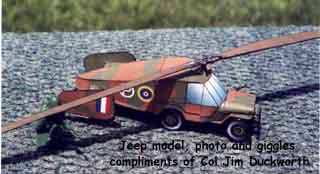 Good morning Sir Chip:
Good morning Sir Chip: